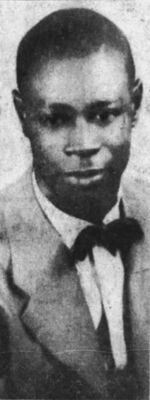Felix Gaines
Felix Benjamin Duncan Gaines (born July 29, 1908 in Birmingham; died June 5, 1991 in Birmingham) was an artist and Parker High School art teacher, known for his book illustrations, painted murals, and patented "Psycho-Beautigraph" etchings of notable persons, which were sold widely for display in schools and churches.
In the 1930 U.S. Census Gaines was listed as the 21-year-old son of Ada Duncan and the stepson of Sandy Coleman, living with them in a house on 9th Court North in Birmingham and working as a laborer at a mattress factory. He was recorded as able to read and write, but as not having attended school. Gaines later told a journalist that he, "worked his way through school by digging ditches, working at pipe shops, and selling iron, rags and bones."
Gaines became recognized locally as the "Dream Artist" because he brought to life visions that came to him in his dreams. During the Great Depression he performed as part of the "Colored Unit" of Birmingham's Federal Theatre Project. Soon his skills earned him an opportunity to train with the Works Progress Administration at the Federal Schools of Art in Minneapolis, Minnesota. He later earned a degree from Ohio State College.
By 1941 Gaines had joined the faculty of Parker High School as the first teacher of commercial art in the Birmingham City Schools system. The success of his program led the board to expand it to Tuggle Elementary School, Pratt Elementary School, East Thomas Elementary School and the Parker High School Annex.
Gaines was enlisted to provide illustrations for the WPA Federal Writers Project's Alabama: A Guide To The Deep South, which was published by the Alabama State Planning Commission in 1941. He continued to furnish artwork for the Birmingham City Almanac published by the Jefferson County Health Department, and for various publications of the Alabama Defense Council. In February 1942, while he was living at 440 Thomas Street, his patriotic poster design was selected by the U.S. Government for an edition of 75,000 copies.
Gaines also executed two large-scale murals for the WPA entitled "Agriculture" and "Swing Low, Sweet Chariot", which were displayed in the Colored Community House and Farm Bureau in Selma. In 1943 Gaines was tapped to serve as director of the United Service Organization's George Wilson Center, set up in the Community House to entertain Black troops stationed at Craig Field in Selma.
After returning to Birmingham Gaines was awarded a "scholarship for advanced study" from the Birmingham City Commission, led by Cooper Green. In 1946 he began touring the state to promote art education for Black students. He also toured more widely around the South, with assistant Elliot Robbins, to promote the sale of his series of photolithographic prints illustrating notable persons such as President Franklin Roosevelt and Tuskegee Institute scientist George Washington Carver. He marketed the distinctive black-and-white etchings, sometimes described as "Peanut Etchings", as examples of his "Psycho-Beautigraph" method, which was intended to convey the experience of color through patterns of lines in the image. He hoped that schools and other groups would buy the prints to display for inspiration.
In 1952 Gaines published a detailed map of Alabama counties listing and depicting hundreds of products which Dr Carver had developed from peanuts and sweet potatoes. The hatching on the map formed a large cross, reflecting Carver's words, "I work under the direction of God," which were also included in the image. By 1955 Gaines was "national artist and director" of the "Dr Carver Program", and founder and editor of the Southern Guide Magazine.
Gaines died in 1991. Little was known about him in 1992 when his 1930s Selma murals were moved from the former community center to the newly-opened Old Depot Museum.
References
- "Local Artist Wins Unique Distinction" (February 20, 1942) The Weekly Review, p. 1, 5
- "Magic City Artist Gains Recognition" (June 1, 1947) Mobile Press-Register
- "Negro Schools, Churches to Get Carver Portraits" (April 28, 1949) St Petersburg Evening Independent, p. 19
- "Leaders Endorse Educator's Plan" (March 18, 1955) The Lowndes Signal, p. 4
- Plott, Bill (February 23, 1992) The Birmingham News/The Montgomery Advertiser, p. 10E
- Wright, Helena E. (February 13, 2015) "Intriguing images of Dr. George Washington Carver" O Say Can You See weblog. National Museum of American History
- Wright, Helena E. (February 26, 2016) "Family research adds to our knowledge of Dr. George Washington Carver portrait" O Say Can You See weblog. National Museum of American History
- Rudder, Justin A. (Spring 2021) "Black Heritage at Selma's Old Depot Museum." Alabama Heritage. No. 140, pp. 22–31
External links
- Museum Minute: Felix B. Gaines, Selma Old Depot Museum
